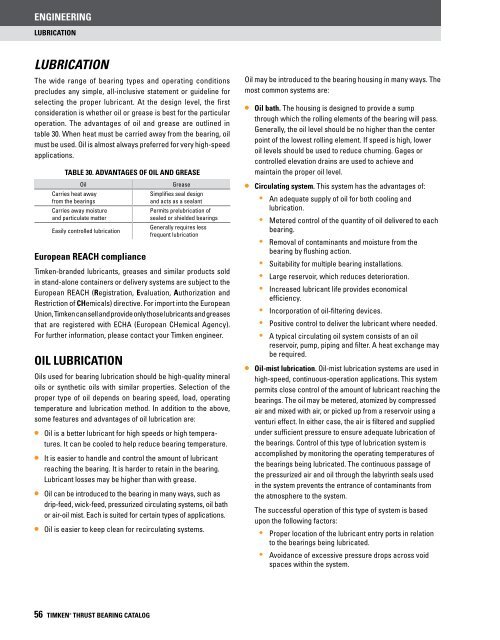Create successful ePaper yourself
Turn your PDF publications into a flip-book with our unique Google optimized e-Paper software.
ENGINEERING<br />
LUBRICATION<br />
Lubrication<br />
The wide range of bearing types and operating conditions<br />
precludes any simple, all-inclusive statement or guideline for<br />
selecting the proper lubricant. At the design level, the first<br />
consideration is whether oil or grease is best for the particular<br />
operation. The advantages of oil and grease are outlined in<br />
table 30. When heat must be carried away from the bearing, oil<br />
must be used. Oil is almost always preferred for very high-speed<br />
applications.<br />
TABLE 30. Advantages of oil and grease<br />
Oil<br />
Carries heat away<br />
from the bearings<br />
Carries away moisture<br />
and particulate matter<br />
Easily controlled lubrication<br />
European REACH compliance<br />
Grease<br />
Simplifies seal design<br />
and acts as a sealant<br />
Permits prelubrication of<br />
sealed or shielded bearings<br />
Generally requires less<br />
frequent lubrication<br />
<strong>Timken</strong>-branded lubricants, greases and similar products sold<br />
in stand-alone containers or delivery systems are subject to the<br />
European REACH (Registration, Evaluation, Authorization and<br />
Restriction of CHemicals) directive. For import into the European<br />
Union, <strong>Timken</strong> can sell and provide only those lubricants and greases<br />
that are registered with ECHA (European CHemical Agency).<br />
For further information, please contact your <strong>Timken</strong> engineer.<br />
Oil Lubrication<br />
Oils used for bearing lubrication should be high-quality mineral<br />
oils or synthetic oils with similar properties. Selection of the<br />
proper type of oil depends on bearing speed, load, operating<br />
temperature and lubrication method. In addition to the above,<br />
some features and advantages of oil lubrication are:<br />
••<br />
Oil is a better lubricant for high speeds or high temperatures.<br />
It can be cooled to help reduce bearing temperature.<br />
••<br />
It is easier to handle and control the amount of lubricant<br />
reaching the bearing. It is harder to retain in the bearing.<br />
Lubricant losses may be higher than with grease.<br />
••<br />
Oil can be introduced to the bearing in many ways, such as<br />
drip-feed, wick-feed, pressurized circulating systems, oil bath<br />
or air-oil mist. Each is suited for certain types of applications.<br />
••<br />
Oil is easier to keep clean for recirculating systems.<br />
Oil may be introduced to the bearing housing in many ways. The<br />
most common systems are:<br />
••<br />
Oil bath. The housing is designed to provide a sump<br />
through which the rolling elements of the bearing will pass.<br />
Generally, the oil level should be no higher than the center<br />
point of the lowest rolling element. If speed is high, lower<br />
oil levels should be used to reduce churning. Gages or<br />
controlled elevation drains are used to achieve and<br />
maintain the proper oil level.<br />
••<br />
Circulating system. This system has the advantages of:<br />
• An adequate supply of oil for both cooling and<br />
lubrication.<br />
• Metered control of the quantity of oil delivered to each<br />
bearing.<br />
• Removal of contaminants and moisture from the<br />
bearing by flushing action.<br />
• Suitability for multiple bearing installations.<br />
• Large reservoir, which reduces deterioration.<br />
• Increased lubricant life provides economical<br />
efficiency.<br />
• Incorporation of oil-filtering devices.<br />
• Positive control to deliver the lubricant where needed.<br />
• A typical circulating oil system consists of an oil<br />
reservoir, pump, piping and filter. A heat exchange may<br />
be required.<br />
••<br />
Oil-mist lubrication. Oil-mist lubrication systems are used in<br />
high-speed, continuous-operation applications. This system<br />
permits close control of the amount of lubricant reaching the<br />
bearings. The oil may be metered, atomized by compressed<br />
air and mixed with air, or picked up from a reservoir using a<br />
venturi effect. In either case, the air is filtered and supplied<br />
under sufficient pressure to ensure adequate lubrication of<br />
the bearings. Control of this type of lubrication system is<br />
accomplished by monitoring the operating temperatures of<br />
the bearings being lubricated. The continuous passage of<br />
the pressurized air and oil through the labyrinth seals used<br />
in the system prevents the entrance of contaminants from<br />
the atmosphere to the system.<br />
The successful operation of this type of system is based<br />
upon the following factors:<br />
• Proper location of the lubricant entry ports in relation<br />
to the bearings being lubricated.<br />
• Avoidance of excessive pressure drops across void<br />
spaces within the system.<br />
56 TIMKEN ® THRUST BEARING CATALOG

















